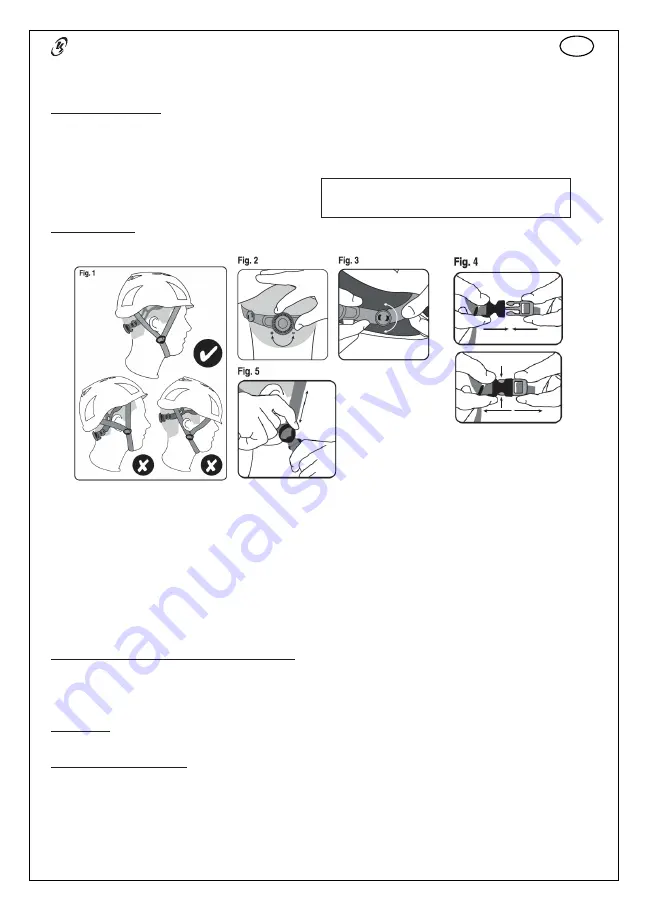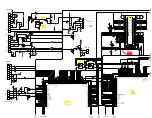
7
GB
This guide must be translated (where applicable) by the dealer in the language of the country where the equipment is used.
For your safety, comply strictly with the instructions for use, verification, maintenance and storage.
KRATOS SAFETY cannot be held liable for any direct or indirect accident occurring following use other than that provided for in these instructions;
do not use this equipment beyond its limits!
USE AND PRECAUTIONS:
A helmet is a piece of personal protective equipment and should be allocated to a single user (it can only be used by one
person at a time). This helmet is recommended for mountaineering
and climbing
activities.
EXCEPTION: This helmet may also be used in activities for which risk analysis reveals that the risk of losing the helmet in a fall (chinstrap able to
withstand 50daN) and striking a surface is greater than the risk of an object falling on the wearer.
Activities performed at height are by their very nature dangerous, and place the head at serious risk of injury. A helmet greatly reduces the consequences
of these risks, but cannot completely remove them. When subjected to violent impacts, the helmet is designed to absorb as much energy as possible by
losing its shape, sometimes to the point of breaking.
Before you use the helmet:
- Read and understand all of the instructions for using the helmet
- Be fully aware, or even trained, in how to use it
- Know what the product can do, and what it cannot
- Understand and accept the risks incurred
The labels inside the helmet should not be removed.
Adjusting the helmet:
Before using the helmet, adjust it to suit the size of the person wearing it.
1. Before you put the helmet on, turn the headband adjuster knob anticlockwise until it is its maximum length.
2. Put the helmet on and adjust the headband using the adjuster knob (turn clockwise to tighten, anticlockwise to loosed) until you reach the desired
length (Fig.2).
3. To adjust the fit more closely, you can adjust the angle of the helmet on your head (Fig.3).
4. Close the chinstrap as shown in Fig. 4, until you hear the click as the buckle locks into place. Pull on the chinstrap to make sure the buckle is closed
properly. Tighten the chinstrap to a comfortable length.
To open the buckle, press the buttons on either side of the buckle and move the two sections away from each other.
5. Adjust the vertical position of the chinstrap by sliding the connecting buckle along the strap (Fig. 5).
A properly adjusted helmet limits the risk of it coming off. Check that it is centred on the head, and that the headband and chinstrap are properly adjusted.
The sliding connecting buckle should be adjusted until it is just under the ears, and there should be no slack in the chinstrap where it meets the headband
(Fig. 1). When using the helmet, regularly check that it is still properly adjusted.
Warning!
Certain medical conditions can affect user safety, if in doubt please contact your doctor.
Be aware of dangers that can reduce the effectiveness of your equipment and therefore your safety. These include exposure to extreme temperatures
(<-30°C or >50°C), in a car for example, prolonged exposure to the elements (UV rays, humidity), chemical products, electricity, or sharp edges,
friction or cuts, etc. Ingredients in glues and paints can also alter the helmet’s performance: check that any such products you use are compatible with
polypropylene.
Check the condition of the helmet every time you are going to use it: visual inspection to check the status of the outer shell, headband, and chinstrap: no
small tears, burns, cracks, unusual shrinkage, deformity or oxidation. Check that the buckle is working properly. If any defects are found or suspected,
the helmet should not be reused. The product should not be used after a major impact, and should be thrown away.
DO NOT remove, add, or replace any of the helmet’s components (apart from the headband, which is available as a spare part and can be
replaced).
TECHNICAL SPECIFICATIONS:
Strap material: Polyester, Shell: Polypropylene, Plastic parts: Polyamide, Insert: Polystyrene.
INSPECTION:
The helmet has an indicative service life of 10 years, but this duration may increase or decrease depending on how it is used and/or the result of annual
checks. We recommend annual checks are carried out by a KRATOS SAFETY approved individual. When in doubt, check the helmet.
MAINTENANCE AND STORAGE:
(These instructions must be strictly observed)
Keep the helmet away from any sharp objects during transport, and store it in its packaging. Do not squash your helmet. Impacts can damage your
helmet. Don’t drop it.
Clean the shell using soapy water. Dry it with a clean cloth and hang it in a well-ventilated space to dry naturally, away from any naked flames or sources
of heat. The same is true for helmets that get wet when in use. Some (internal) parts can be removed for easy cleaning. Bleaches and detergents are
strictly prohibited.
The helmet should be stored in a cool, dry, well-ventilated space in its packaging, away from direct sunlight, heat, and chemical products.
You are responsible for your own actions, and failure to follow
the instructions for using the helmet may result in serious
injuries, or even death.
Содержание HP 10 200 00B
Страница 11: ...11...
Страница 12: ...12 NOTES...


































